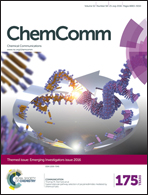E–H (E = B, Si, Ge) bond activation of pinacolborane, silanes, and germanes by nucleophilic palladium carbene complexes†
Abstract
The reactivity of two nucleophilic palladium carbenes, [PC(sp2)P]Pd(PMe3) and [PC(sp2)P]Pd(PPh3), where [PC(sp2)P] = bis[2-(di-iso-propylphosphino)phenyl]methylene, toward the E–H bond activation of Ph4−nEHn (E = Si, Ge; n = 1–3) and pinacolborane (HBpin) is discussed. Unlike previous reports, both types of isomer species, hydride [PC(EHn−1Ph4−n)P]PdH or [PC(Bpin)P]PdH and silyl/germyl [PC(H)P]Pd(EHn−1Ph4−n), were observed depending on the substrate and the phosphine ligand, showing that the polarity of the Pd–C bond can be tuned by the phosphine substituents.

- This article is part of the themed collection: 2016 Emerging Investigators

 Please wait while we load your content...
Please wait while we load your content...